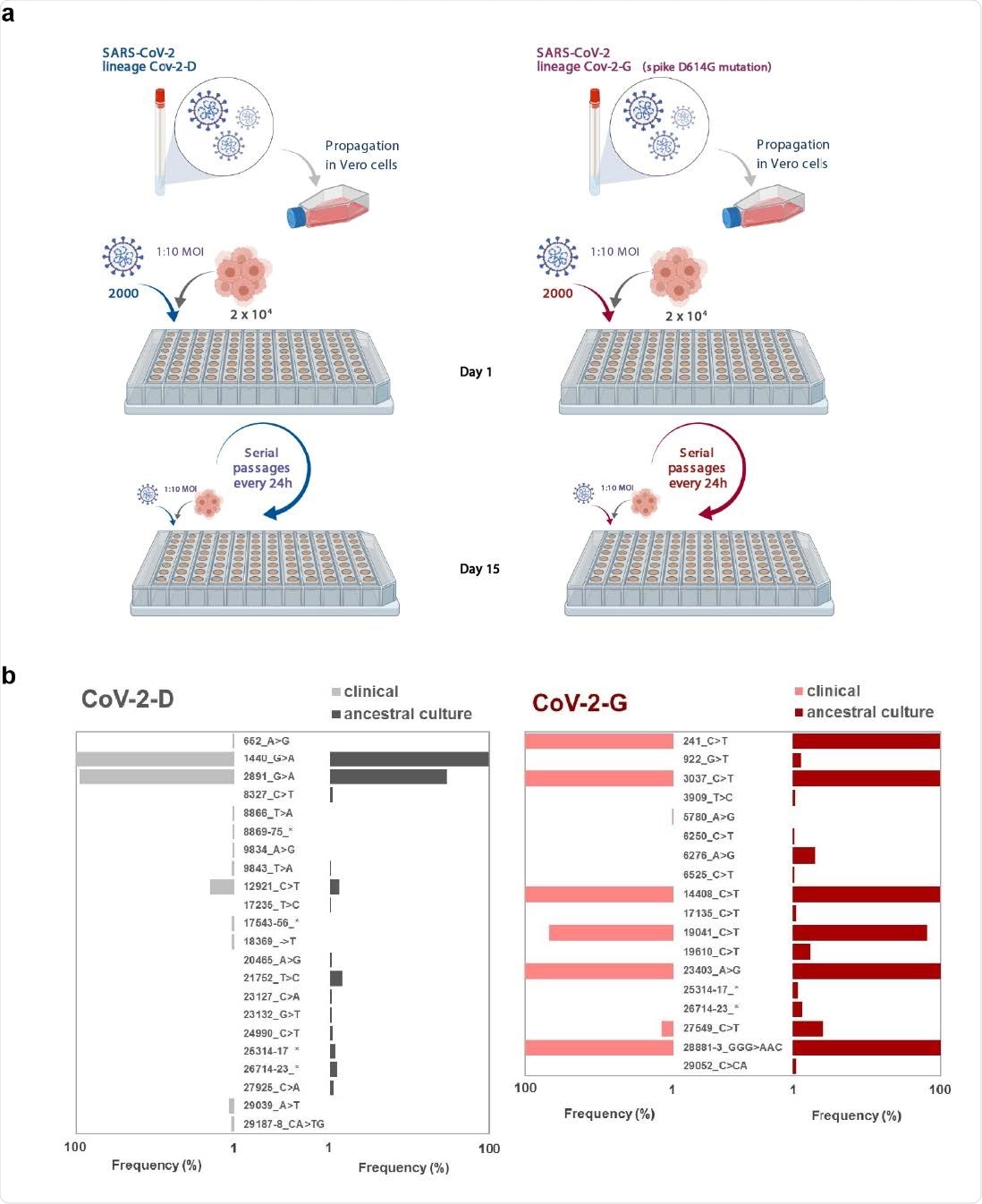A team of scientists from Portugal has recently estimated the rate of mutation in two circulating variants of severe acute respiratory syndrome coronavirus 2 (SARS-CoV-2) using experimental evolution methods. Their findings reveal that in a condition with no immune surveillance, SARS-CoV-2 can potentially undergo evolution during the first stages of infection. The study is currently available on the bioRxiv* preprint server.
The acquisition of mutations is the primary driving force for viral evolution. The predictability of viral evolution can be assessed by estimating the rate of genomic mutations. DNA viruses generally exhibit a constant mutation rate, while RNA viruses vary widely in mutation rate. In pathogens, mutations are originated in response to selection pressures, including therapeutics, cell types, and host immune responses. During viral lifecycle, a gradual accumulation of mutations under positive selection leads to the emergence of new viral variants with improved fitness.
Since its emergence in December 2019 in China, SARS-CoV-2, the causative pathogen of coronavirus disease 2019 (COVID-19), has undergone more than 12,000 mutations. Most of these mutations are present in the spike glycoprotein. However, the actual rate of mutation is not known for SARS-CoV-2.
In the current study, the scientists have performed experimental evolution together with whole-genome sequencing in SARS-CoV-2 variants to estimate the genomic mutation rate, as well as to characterize mutation accumulation along the viral genome.
For the experiments, they have selected two circulating variants of SARS-CoV-2: the original viral strain with D614 spike and the mutated variant with G614 spike. The D614G spike mutation characterized in the study emerged early in the pandemic and caused a significant induction in viral infectivity. Soon after emergence, variants with D614G mutation became predominant globally.
Important observations
The SARS-CoV-2 variants isolated from two COVID-19 patients were continuously propagated in cells. The virus-infected cells were seeded on a 96-well plate and passaged for 15 days, leading to the generation of 96 virus-derived lines for each viral variant.
For the D614 variant, the propagation of 96 lines resulted in the accumulation of 1,753 novel mutations; of which, 415 were synonymous mutations, 971 were non-synonymous mutations, 367 were other types of mutations. By analyzing the accumulated mutations and their frequencies at passage 15, the scientists estimated a mutation rate of 3.7x10-6 per genome per infection cycle for the D614 lineage.
For the G614 variant, the propagation of 96 lines resulted in the accumulation of 6,181 novel mutations; of which 724 were synonymous mutations, 4,313 were non-synonymous mutations, 1144 were other types of mutations. Notably, the scientists observed the emergence of a mutator virus in some of the lines of the G614 variant. These mutators had significantly higher numbers of mutations than non-mutators. By excluding mutators, they estimated a mutation rate of 2.9x10-6 per genome per infection cycle for the G614 lineage. The statistical analysis revealed that the difference in mutation rate between D614 and G614 variants is slight but significant. Assuming that all mutations are neutral, these findings indicate a reduction in mutation rate for the G614 genomic background.
With further analysis, the scientists identified that mutations accumulating in RNA-dependent RNA polymerase and/or error-correcting exonuclease protein might be responsible for the emergence of mutator viruses.

Experimental evolution design and ancestor backgrounds. a, Schematic of the experimental design of the mutation accumulation experiments where two viral backgrounds were propagated in Vero cells (created with BioRender.com). b, Mutations and their frequencies in the clinical isolates and their corresponding derived ancestors for the propagations. For the sake of figure simplicity, the complex mutations indicated in the figure with an asterisk correspond to: 8869-75_TTTGCCT>CAAACCA; 17543- 56_TGTTCCTCGGAACT>AGTTCCGAGGAACA; 25314-17_GATC>TATG; 26714- 23_TTTTGTGCTT>-GTTGTAC- -
By conducting a series of simulation experiments, the scientists observed significant variation in the rate of mutation accumulation along the viral genome. Furthermore, they noticed that among different genomic regions of the D614 and G614 variants, the spike gene has the highest rate of mutation accumulation. For the D614 variant, they observed that the spike mutation rate is almost 5-fold higher than the genome average. However, a significantly lower spike mutation rate was observed for the G614 variant.
Regarding types of mutations, the scientists observed the highest rate of non-synonymous mutation accumulation in the spike gene of both D614 and G614 variants. Taken together, these observations indicate that during viral propagation in cells, the spike evolution is shaped by natural selection.
By quantifying the convergence level between the two variants, they revealed that 17 sites and 3 small regions in the spike gene demonstrate evolutionary convergence at the nucleotide level. At the amino acid level, 20 sites and 3 regions showed convergence. Specifically, they observed that three distinct deletion mutations emerged multiple times at the spike S1/S2 cleavage site (furin cleavage site) for both variants. With further analysis, they suggested that conformational changes associated with the spike D614G mutation may influence the viral evolution toward the elimination of furin cleavage site.
Study significance
The study reveals that the rate of spontaneous mutation in SARS-CoV-2 is 0.1 per genome per infection cycle. Importantly, SARS-CoV-2 with a higher mutation rate can emerge within 15 days of its proliferation in cells.
Overall, the study highlights the potency of SARS-CoV-2 to adapt to new environments via convergent evolution of specific spike mutations.